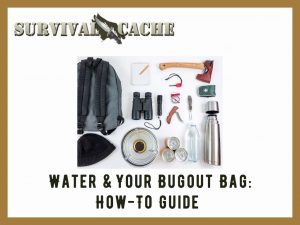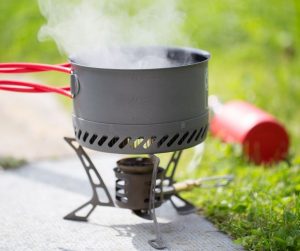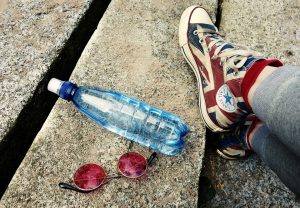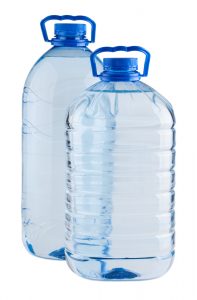Water is one of the most precious resources we have. Given how critical it is to life and our need for it, anything related to having clean water should always be in the front of our minds.
Having a potable water plan when staying in one location takes effort but is easily doable. A home or bug out location will generally have ample supplies for collecting, filtering, purifying, and storing water.

A person who is highly prepared for emergencies will have hundreds if not thousands of gallons of clean water stored away somewhere safe.
But how do you take care of water needs when you need to bug out and stay on the move? Especially when all you have is in your bug out bag.
While it is not absolute, if you go by the rule of three a person cannot go more than three days without water.
Carrying hundreds of gallons of water in a BOB is not an option. Some water can and should be carried in a pack but there is no way to carry enough to last the duration of a long trip.
We may not be able to physically carry hundreds of gallons of water, but we can carry the means to make hundreds if not thousands of gallons of potable water.
If you have any inclination or plans to bug out during an emergency, it is critical to take the time to thoroughly think through the items in your bag.
This is even more important as it pertains to acquiring drinkable water.
In the following article, I will be discussing some of the supplies and methods that will help you stay hydrated with nothing more than your BOB.
Let’s dive right in, starting with the topic of bottled water.
SKIP AHEAD
Bug Out Bag Water Storage Methods
Bottled Water
Carrying bottled water in a BOB is a viable option. The biggest downfall of bottled water is the container is not meant for long-term storage.
Under optimal conditions, bottled water should be rotated out once a year.
Most of us keep our BOB in less-than-optimal conditions, such as the trunk of a car or stuck in the back of a closet. The BOB tends to sit there for long periods without ever being used.
This becomes a problem if the water has been in the bag longer than it should and it has been subjected to temperature extremes.
The longer the water sits in this type of plastic bottle, the more likely the plastic will begin leaching into the water.
When using bottled water in your bag it is important to keep track of how long it has been stored and to avoid exposing it to extreme temperatures.
But most of us will probably forget about keeping track of this so here is a better option.
Always keep a couple of fresh bottles of water available that can be quickly packed into a bag at a moment’s notice. This way you know you have fresh water in your bag when things suddenly go sideways.
Packing Bottled Water
Choose whatever brand of water you like but here is a recommendation for the size of the bottle to get.
One-liter bottles provide a decent amount of water while providing a durable container. Smaller bottles tend to be made from thinner plastic that may not hold up well to abuse.
I suggest packing at least two bottles if there is room in your pack. This way, when one of the bottles is empty it can be sacrificed and used for another purpose.
Containers
One of the most important items you are going to need in your bag is a container that will help to collect water and transport it. Below are a few good options
Bottles
A water bottle is an obvious choice. Nowadays, many people already have one of these that they carry around most of the time.
But if you do not have one, they can be picked up at most stores and they are quite affordable.
There are two main kinds of bottles to choose from and each has its ups and downs.
Plastic Water Bottles
When choosing a plastic water bottle it is important to read the labels to ensure it is BPA-free.
After that, the size of the bottle and the drinking spout is a personal preference.
Pros
- Lightweight
- Affordable
- Durable
- Many different sizes and shapes to choose from
- Sold at most stores
Cons
- Cannot be used to boil water. This is a very important negative feature of plastic bottles.
Metal Water Bottles
Generally speaking, there are two different kinds of metal water bottles. Ones made from aluminum and ones made from stainless steel with stainless steel being the more popular options.
Aluminum bottles are slightly cheaper and weigh a little less but they are easily dented.
Stainless steel is more expensive and a bit heavier, but they are much more durable containers.
Pros
- Durable
- Can be used to boil water in
- Depending on size it can also be used to cook in
- Reflective metal surfaces can double as a signaling device
Cons
- More expensive
- Heavier
- Can make sounds when being carried on or in a pack
Water Bladders
Water bladders are collapsible, but durable plastic bags that take up little space when empty, but they can hold several liters of water when filled.
There are two popular styles of bladders to choose from.
One type consists of a bladder that is attached to a long flexible tube.
The bladder is placed into a backpack style bag and the tube is wrapped around and attached to the forward section of the shoulder strap.
The tube can then be used as a straw to drink the water without having to stop or remove the bladder from the pack.
The second style is a bladder but without the tubing. The bladder can be carried inside a pack or attached to the exterior.
While the second type of bladder may not be as convenient as the first type, it still provides an effective way of collecting and transporting water.
Resealable Bags
Resealable plastic bags of all shapes and sizes are a great item to always have in a pack because they are incredibly useful.
You can choose bags that are sandwich-sized or larger one-gallon sized bags.
Considering that these can be purchased cheaply at most food stores, it would be a good idea to have several different sizes in your pack.
These bags can be used to collect water from streams or ponds, rainwater, and even from green vegetation.
While this should not be carried as a primary water container, it is a great backup and takes up little space in a pack.
Filters
Drinking unclean water can expose you to things like E. coli, giardia, and cryptosporidium. Consuming untreated water can make you ill and cause vomiting or diarrhea which leads to further dehydration.
Once a source of water is found and collected, it needs to be filtered to remove large debris, sediment and depending on the filter, microorganisms, and harmful compounds.
Even after water has been filtered, it is best to boil or chemically treat the water to ensure it is safe to drink.
Sawyer Mini
One of the best and most popular filters around is the Sawyer Mini.
It is a simple product that consists of a filter, a small tube, a collection pouch, and a syringe.
The filter size is 0.1 microns which remove 99.99% of bacteria, protozoa, and microplastics.
The Sawyer Mini is hard to beat considering its small size and that the filter is rated for use up to 100,000 gallons.
Last update on 2024-04-24 at 10:52 / Affiliate links / Images from Amazon Product Advertising API
Seychelle Water Bottle
This product is another great choice because it is incredibly easy to use and convenient.
To use, it is as simple as unscrewing the lid, filling up the bottle, and screwing the lid back on.
The filter that is attached to the drinking straw is rated for up to 100 gallons and removes the following from dirty water.
- 99.99% of bacteria and viruses
- Sediments
- Chlorine
- VOC’s
- Dissolved heavy metals
- ✅ PERFECT FOR CAMPING AND INTERNATIONAL TRAVEL - Clean, safe drinking water is a MUST for...
- ✅ ADVANCED FILTER TECHNOLOGY - This high end portable water bottle allows you to drink from...
Last update on 2024-04-24 at 10:52 / Affiliate links / Images from Amazon Product Advertising API
Cloth Filters
In the absence of a proper water filter, an improvised filter can be made by using a piece of material such as a shirt, bandanna, or handkerchief.
First, place the material over the opening of a collection container. Then allow the water to flow over the filter and into the container.
This will not remove microorganisms or other harmful compounds, but it does a good job of separating large debris and some sediment.
Field Filter
A field filter can be relatively easy to make with minimal materials.
Take an extra, disposable water bottle and cut away the bottom.
Invert the bottle and begin layering in the material that progressively becomes larger. Start with charcoal, then sand, small pebbles, and then larger rocks.
If a clean cloth is available, place it over the drinking spout of the bottle which is now at the bottom.
Pour water into the top and allow it to filter through the layers. Collect the water as it drips through the cloth.
5 Ways to Purify Water
Boiling

Boiling water is one of the simplest and most common methods for creating potable water.
Heating water to the point of boiling and allowing it to boil for a minimum of sixty seconds will kill or inactivate most harmful microorganisms.
This process is most effective when the water is filtered first then boiled.
Bleach
When boiling water is not an option, household bleach can be used to kill most harmful microorganisms.
This process is more effective if the water is filtered before the addition of bleach.
The rule of thumb is to use roughly eight drops of bleach per one gallon of water. If the water is cloudy or discolored, the number of drops can be doubled.
After the bleach has been added to the bottle, briefly mix the contents up by shaking and allow the water to sit for a minimum of thirty minutes before drinking.
Purification tablets
These tablets are popular among outdoorsman as they come in ready to use pre-measured tablets.
The water should be filtered as best as possible before the addition of the tablets.
Usually, the active ingredient in these is either chlorine or iodine, which is what makes the water safe to drink.
The number of tablets used is dependent on the amount of water available. After the tablets have been added you typically only have to wait about thirty minutes before drinking.
Iodine
Iodine drops are another viable option for creating safe drinking water.
Before adding the iodine, filter the water as much as possible.
According to the EPA, five drops of a 2% tincture of iodine can be added for each liter of water.
As was the case with the bleach method, if the water is cloudy or discolored the number of drops can be doubled.
Mix the water and iodine solution and allow it to sit for a minimum of thirty minutes before drinking.
UV Light
When none of the above methods are available, water can be disinfected by using the Sun.
Small clear bottles of water can be disinfected by using the UV rays that are emitted from the Sun. The UV rays destroy some microbes and can make water safer to drink.
However, this is a long process and is most effective with small bottles of water. Expect to leave the water in direct sunlight for at least six hours.
How Much Water Should I Carry?
One of the top questions that everyone wants a firm answer to, “how much water should I carry in my BOB?”
To be honest there is no clear answer to this question and here are some of the reasons why.
On average the human body requires 2-4 liters of water every day. For reference, approximately 3.5 liters is one gallon of water.
But this amount can be less or more depending on age, gender, weight, how much food is consumed, any medications a person may be taking, temperature, and physical exertion.
Next, the weight of water needs to be taken into consideration. One gallon of water, which is roughly enough for one day, weighs just over eight pounds.
When carrying a pack on your back, the weight adds up quickly and water is not the only item you will want to carry in a BOB.
The average person is going to have a BOB weighing between 25-50 pounds.
If you added three days of water, or three gallons, that would be 24lbs of just water.
As you can see, adding just a small amount of water to a BOB takes up most of a person’s carrying capacity.
So what’s the answer?
The best course of action is to locate viable water sources along a bug out route. Initially, enough water should be carried to maintain a person until the first source of water can be reached.
Once there, water can be filtered, cleaned, and collected. By repeating this process over and over along the route, you will have enough water to drink without breaking your back.
How to Carry Water in a Bug Out Bag
Once you have chosen a container for your water you then need to decide how you want to carry it.
If you are using a pack with an internal bladder then the water container is already being carried on the interior of the bag.
But when it comes to a hard container, such as a water bottle, there are two options available.
Interior or Exterior?
The bottle can be carried either on the outside of the bag or on the inside.
This may seem like an unimportant aspect to think about but that could not be further from the truth.
There are two ways for carrying a water bottle on the outside of a pack and I am not a fan of either of them.
The first is in a side pocket or under a strap. The second way that has been popularized is by hanging the bottle by a cheap carabiner or cordage.
In my opinion, both options put a precious resource at risk.
I have seen or personally experienced a bottle of water falling out of a side pocket or breaking free from a carabiner or strap.
When this happens the water bottle can become lost or even possibly break, spilling the drinking water onto the ground.
The best way to carry water in a BOB is to make room for it on the interior of the bag where it is most protected.
Simple Trick Before Bugging Out
It is widely accepted that during normal times, most people do not drink enough water daily.
So, when it is time to bug out many people will already be dehydrated which is not a good situation to be in.
If there is adequate time before bugging out, hydrate as much as possible. This will put you in a better position physically and helps to stretch out a BOB’s water supply.
Putting it All Together
There was a lot of information laid out in this article so here is a quick rundown and summary.
- Stay hydrated
- Have fresh water read to pack into a BOB
- Have a least one container that can be used for water
- Have supplies for filtering and cleaning the water
- Create a personal plan for collecting water when you bug out
Wrap Up
I hope that this article has helped to shed some light on one of the most critical aspects of a BOB.
Three days is the universally accepted amount of time that we should not go without water.
Even though it is not absolute the rule of three gives you a good baseline for working out water requirements.
I suggest using that amount of time to gauge how much water and water-related supplies you will need to reach your destination both safely and hydrated.
Thanks for reading and stay prepared!





